Alibaba Cloud Virtual Machines For WHMCS
(→Configuration of Server) |
(→Configuration of Server) |
||
| Line 233: | Line 233: | ||
==Configuration of Server== | ==Configuration of Server== | ||
{| | {| | ||
| − | |style="padding: 10px 0px 20px 0px;"|'''Before you can go on, you must generate your Alibaba Cloud access details. You will need them to connect with the server successfully.'''<br/> | + | |style="padding: 10px 0px 20px 0px;"|'''Before you can go on, you must generate your Alibaba Cloud Virtual Machines access details. You will need them to connect with the server successfully.'''<br/> |
Underneath, you will find instructions where to find them. | Underneath, you will find instructions where to find them. | ||
|} | |} | ||
{| | {| | ||
| − | |style="padding: 0px 0px 20px 15px;"|'''7. Firstly, log into your Alibaba Cloud account at https://account.alibabacloud.com/ | + | |style="padding: 0px 0px 20px 15px;"|'''7. Firstly, log into your Alibaba Cloud account at https://account.alibabacloud.com/. |
|} | |} | ||
{| | {| | ||
| Line 243: | Line 243: | ||
|} | |} | ||
{| | {| | ||
| − | |style="padding: 0px 0px 20px 15px;"|'''8. Now you need to move to the '' 'Console', '' press the adequate button and you will be redirected there immediately | + | |style="padding: 0px 0px 20px 15px;"|'''8. Now, you need to move to the '' 'Console', '' press the adequate button and you will be redirected there immediately. |
|} | |} | ||
{| | {| | ||
| − | |style="padding: 0px 0px 20px 25px;"|[[File: | + | |style="padding: 0px 0px 20px 25px;"|[[File:ACV_7.png]] |
|} | |} | ||
{| | {| | ||
| − | |style="padding: 0px 0px 20px 15px;"|'''9. Hover over your '' 'Main Account' '' icon in the top right corner of the screen, a dropdown menu will appear. Press the 'AccessKey Management' selection. | + | |style="padding: 0px 0px 20px 15px;"|'''9. Hover over your '' 'Main Account' '' icon in the top right corner of the screen, a dropdown menu will appear. Press the '' 'AccessKey Management' '' selection. |
|} | |} | ||
{| | {| | ||
| − | |style="padding: 0px 0px 20px 25px;"|[[File: | + | |style="padding: 0px 0px 20px 25px;"|[[File:ACV_8.png]] |
|} | |} | ||
{| | {| | ||
| − | |style="padding: 0px 0px | + | |style="padding: 0px 0px 15px 15px;"|'''10. You will be moved to '' 'AccessKey Pair'' section. There, you will be asked to confirm that you wish to '' 'Use Current AccessKey Pair'.'' <br/>Press the button to get access. |
|} | |} | ||
{| | {| | ||
| − | |style="padding: 0px 0px 20px 25px;"|[[File: | + | |style="padding: 0px 0px 20px 25px;"|[[File:ACV_9.png]] |
|} | |} | ||
{| | {| | ||
| − | |style="padding: 0px 0px 20px 15px;"|'''11. If you do not have yet any active keys, | + | |style="padding: 0px 0px 20px 15px;"|'''11. If you do not have yet any active keys, press '' 'Create AccessKey' '' button to generate a new set of details. |
|} | |} | ||
{| | {| | ||
| − | |style="padding: 0px 0px 20px 25px;"|[[File: | + | |style="padding: 0px 0px 20px 25px;"|[[File:ACV_10.png]] |
|} | |} | ||
{| | {| | ||
| − | |style="padding: 0px 0px 15px 15px;"|'''12. A modal with AccessKey ID and AccessKey Secret will appear, so copy | + | |style="padding: 0px 0px 15px 15px;"|'''12. A modal with AccessKey ID and AccessKey Secret will appear, so copy them and keep safe. You may also download a file with the details. '''<br/> |
| − | + | ||
|} | |} | ||
{| | {| | ||
| − | |style="padding: 0px 0px 20px 25px;"|[[File: | + | |style="padding: 0px 0px 20px 25px;"|[[File:ACV_11.png]] |
|} | |} | ||
{| | {| | ||
| − | |style="padding: 0px 0px 15px 15px;"|Note that you can find the corresponding secret key | + | |style="padding: 0px 0px 15px 15px;"|Note that you can find the corresponding secret key later on, it will be accessible next to the Key ID in the panel. |
|} | |} | ||
{| | {| | ||
| − | |style="padding: 0px 0px 20px 25px;"|[[File: | + | |style="padding: 0px 0px 20px 25px;"|[[File:ACV_12.png]] |
|} | |} | ||
{| | {| | ||
| − | |style="padding: 0px 0px | + | |style="padding: 0px 0px 15px 15px;"|'''13. Now that you have you access keys, you may move back to your WHMCS.<br/> Proceed to '' 'System Settings' '' → '' 'Servers' '' and press '' 'Add New Server'.'' |
|} | |} | ||
{| | {| | ||
| − | |style="padding: 0px 0px 20px 25px;"|[[File: | + | |style="padding: 0px 0px 20px 25px;"|[[File:ACV_13.png]] |
|} | |} | ||
{| | {| | ||
| Line 291: | Line 290: | ||
|} | |} | ||
{| | {| | ||
| − | |style="padding: 0px 0px 20px 25px;"|[[File: | + | |style="padding: 0px 0px 20px 25px;"|[[File:ACV_14.png]] |
|} | |} | ||
{| | {| | ||
| Line 297: | Line 296: | ||
|} | |} | ||
{| | {| | ||
| − | |style="padding: 0px 0px 20px 25px;"|[[File: | + | |style="padding: 0px 0px 20px 25px;"|[[File:ACV_15.png]] |
|} | |} | ||
{| | {| | ||
| Line 303: | Line 302: | ||
|} | |} | ||
{| | {| | ||
| − | |style="padding: 0px 0px 30px 25px;"|[[File: | + | |style="padding: 0px 0px 30px 25px;"|[[File:ACV_16.png]] |
|} | |} | ||
Revision as of 11:43, 21 February 2023
Contents |
About Alibaba Cloud Virtual Machines For WHMCS
| Alibaba Cloud Virtual Machines For WHMCS will boost your provisioning business by allowing automated management of Alibaba instances in your WHMCS system. Your clients will be empowered to remotely start, stop, and reboot the server, as well as preview the assignment of IP addresses. |
- Admin Area Features:
| ✔ Create/Suspend/Unsuspend/Terminate Server |
| ✔ Start/Stop/Reboot Server |
| ✔ View Server Status And Details |
| ✔ View Assigned Network Interfaces And IP Addresses Details |
| ✔ View Scheduled Tasks |
| ✔ Configure Product Details: |
| ✔ Choose Region |
| ✔ Choose Amazon Machine Image (AMI) |
| ✔ Select From Amazon Database |
| ✔ Add Own Image By Providing AMI ID |
| ✔ Provide Custom Names For Added Images |
| ✔ Choose Instance Type |
| ✔ Enable Firewall |
| ✔ Select Security Groups |
| ✔ Define Number Of Firewall Rules |
| ✔ Define Number Of IPv4 Addresses |
| ✔ Define Tag Name |
| ✔ Toggle Capacity Reservation |
| ✔ Toggle Hibernation |
| ✔ Toggle API Request Logging |
| ✔ Provide User Data Script |
| ✔ Choose User Data File |
| ✔ Choose Subnet |
| ✔ Choose Volume Type |
| ✔ Define Volume Size |
| ✔ Set Volume IOPS |
| ✔ Define Client Area Configuration |
| ✔ Show Windows Password |
| ✔ Hide DNS Name |
| ✔ Hide Scheduled Tasks |
| ✔ Hide IPv6 |
| ✔ Enable Firewall Configuration |
| ✔ Generate Configurable Options |
| ✔ Run API Connection Test |
- Client Area Features:
| ✔ Start/Stop/Reboot Server |
| ✔ View Server Status And Details |
| ✔ View Assigned Network Interfaces And IP Addresses Details |
| ✔ View Scheduled Tasks |
| ✔ Create/Manage Firewall Rules |
| ✔ Provide SSH Key During Order |
| ✔ Provide SSH Key To Decode Windows Password |
| ✔ Get/Provide SSH Key For Already Created Instance |
- Configurable Options:
| ✔ Region |
| ✔ Instance Type |
| ✔ Amazon Machine Image (AMI) |
| ✔ Number Of IPv4 Addresses |
| ✔ Volume Size [GB] |
| ✔ Volume Type |
| ✔ Number Of Firewall Rules |
| ✔ User Data |
- General Info:
| ✔ Multi-Language Support |
| ✔ Supports PHP 7.4 Up To PHP 8.1 |
| ✔ Supports WHMCS Themes "Six" And "Twenty-One" |
| ✔ Supports WHMCS V8.4 And Later |
| ✔ Easy Module Upgrade To Open Source Version |
Installation and Configuration
| This tutorial will show you how to successfully install and configure Alibaba Cloud Virtual Machines For WHMCS smoothly. We will guide you step by step through the whole process. |
Installation
| 1. Log in to our client area and download the module. |
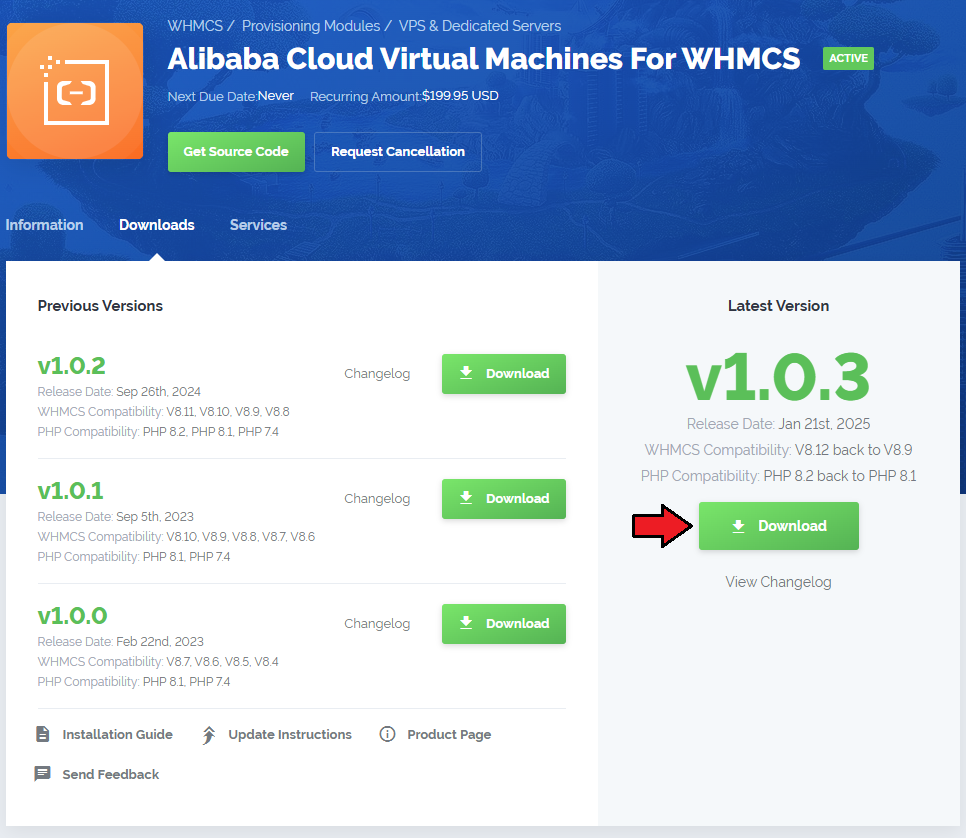
|
| 2. Upload and extract the extension into the main WHMCS directory. Extracted files in your WHMCS directory should look like this: |

|
| 3. When you install Alibaba Cloud Virtual Machines For WHMCS for the first time, you have to rename the 'license_RENAME.php' file. The file is located in '/yourWHMCS/modules/servers/AlibabaCloudVirtualMachines/license_RENAME.php'. Rename it from 'license_RENAME.php' to 'license.php'. |
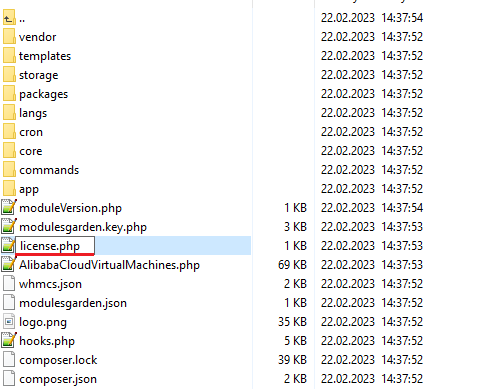
|
| 4. In order to configure your license key, you have to edit the previously renamed 'license.php' file. Enter your license key between the quotation marks as presented on the following screen. |

|
| 5. Now, set up the 'storage' folder as recursively writable. This folder is available at '/yourWHMCS/modules/servers/AlibabaCloudVirtualMachines/'. |
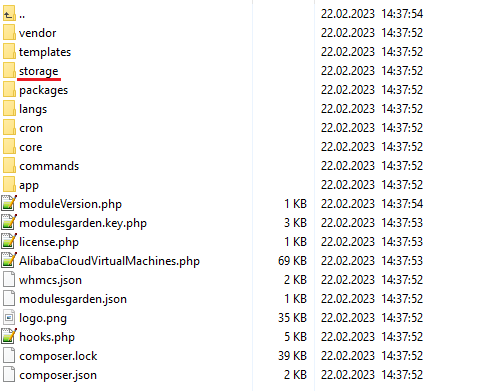
|
| 6. The last step is setting up the queue cron job. It will be used to execute module commands such as: create, terminate or change package. php -q /yourWHMCS/modules/servers/AlibabaCloudVirtualMachines/cron/cron.php queue It is suggested to run the cron every 5 minutes. |
Configuration of Server
| Before you can go on, you must generate your Alibaba Cloud Virtual Machines access details. You will need them to connect with the server successfully. Underneath, you will find instructions where to find them. |
| 7. Firstly, log into your Alibaba Cloud account at https://account.alibabacloud.com/. |
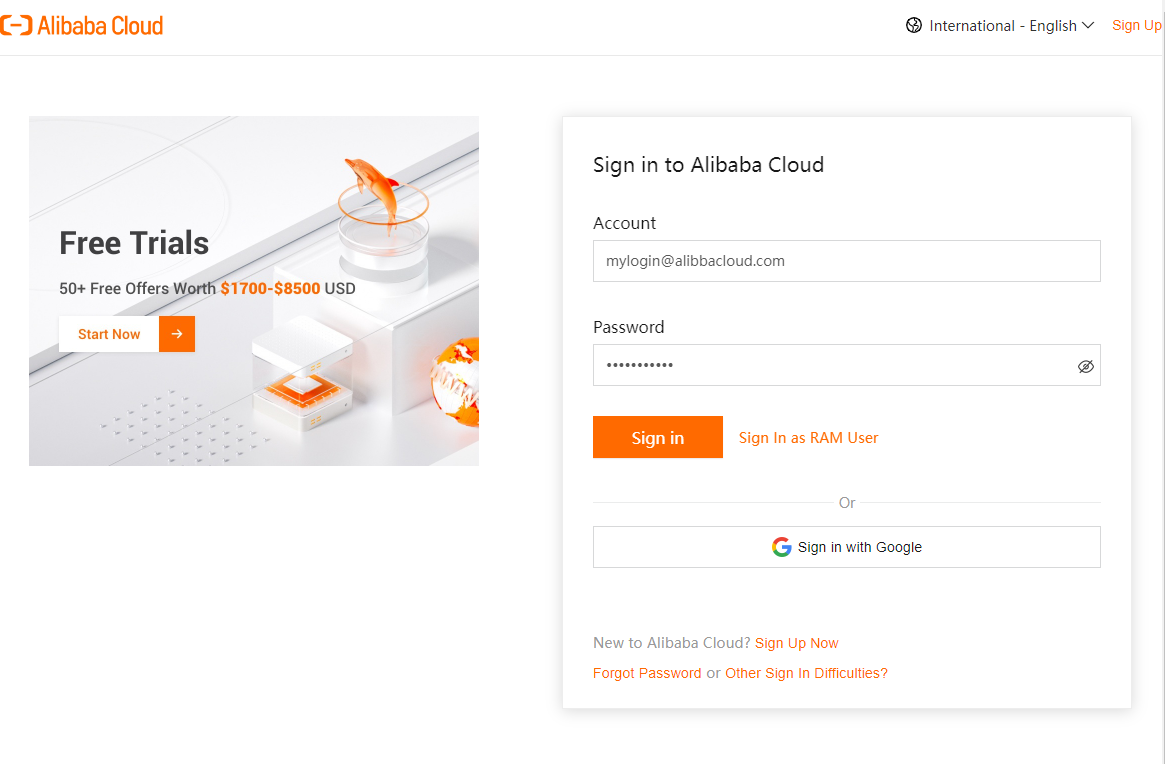
|
| 8. Now, you need to move to the 'Console', press the adequate button and you will be redirected there immediately. |
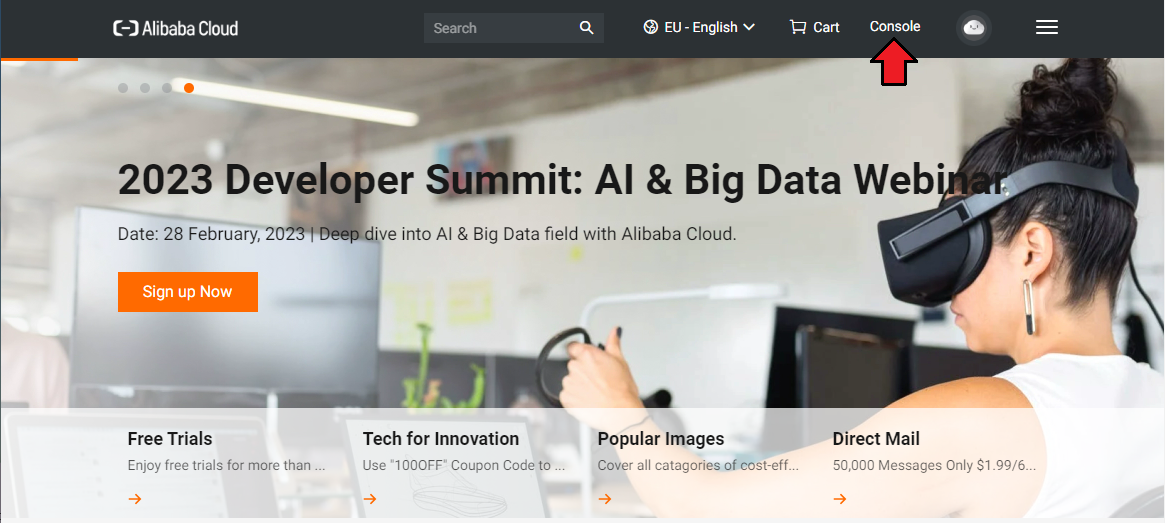
|
| 9. Hover over your 'Main Account' icon in the top right corner of the screen, a dropdown menu will appear. Press the 'AccessKey Management' selection. |
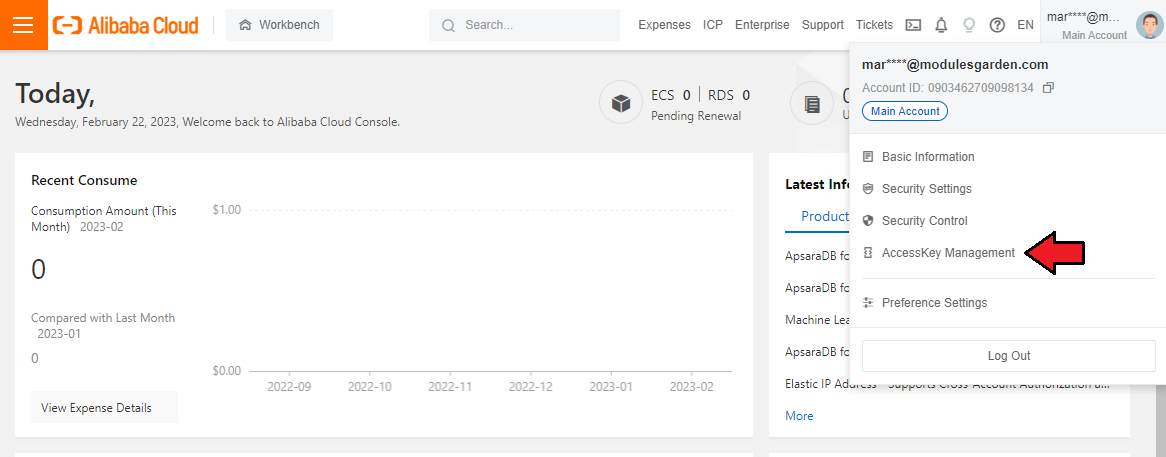
|
| 10. You will be moved to 'AccessKey Pair section. There, you will be asked to confirm that you wish to 'Use Current AccessKey Pair'. Press the button to get access. |
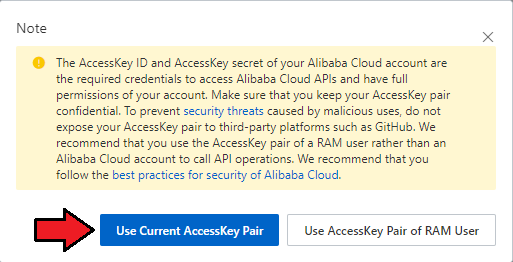
|
| 11. If you do not have yet any active keys, press 'Create AccessKey' button to generate a new set of details. |
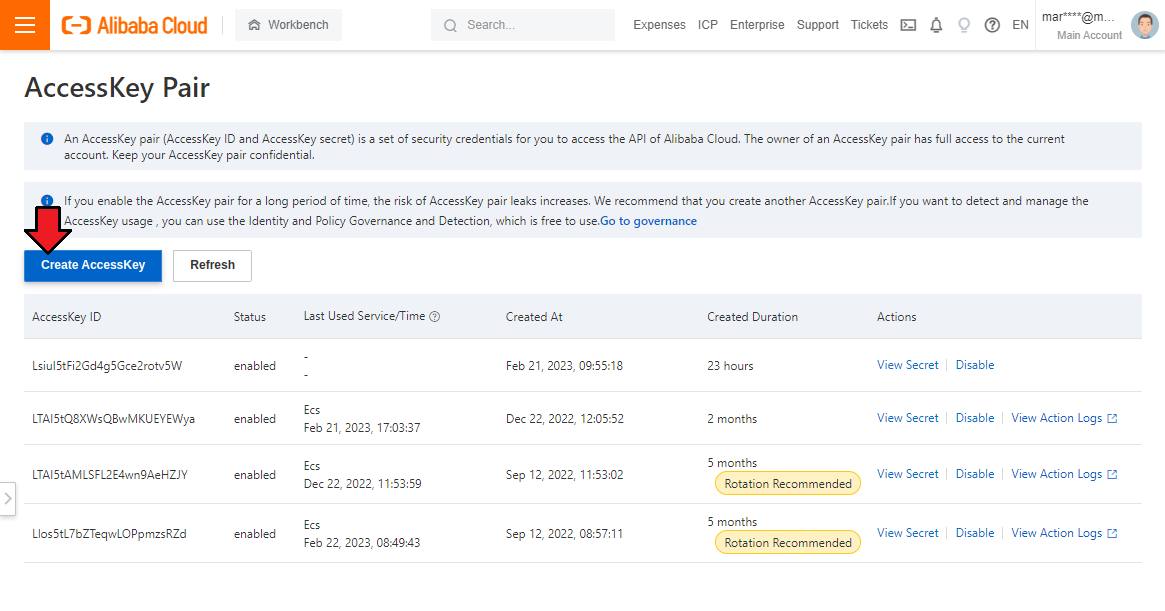
|
| 12. A modal with AccessKey ID and AccessKey Secret will appear, so copy them and keep safe. You may also download a file with the details. |
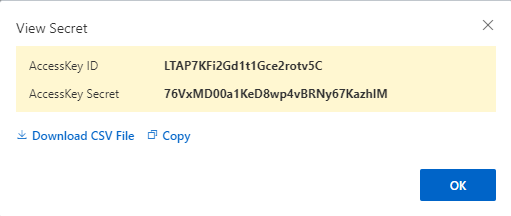
|
| Note that you can find the corresponding secret key later on, it will be accessible next to the Key ID in the panel. |
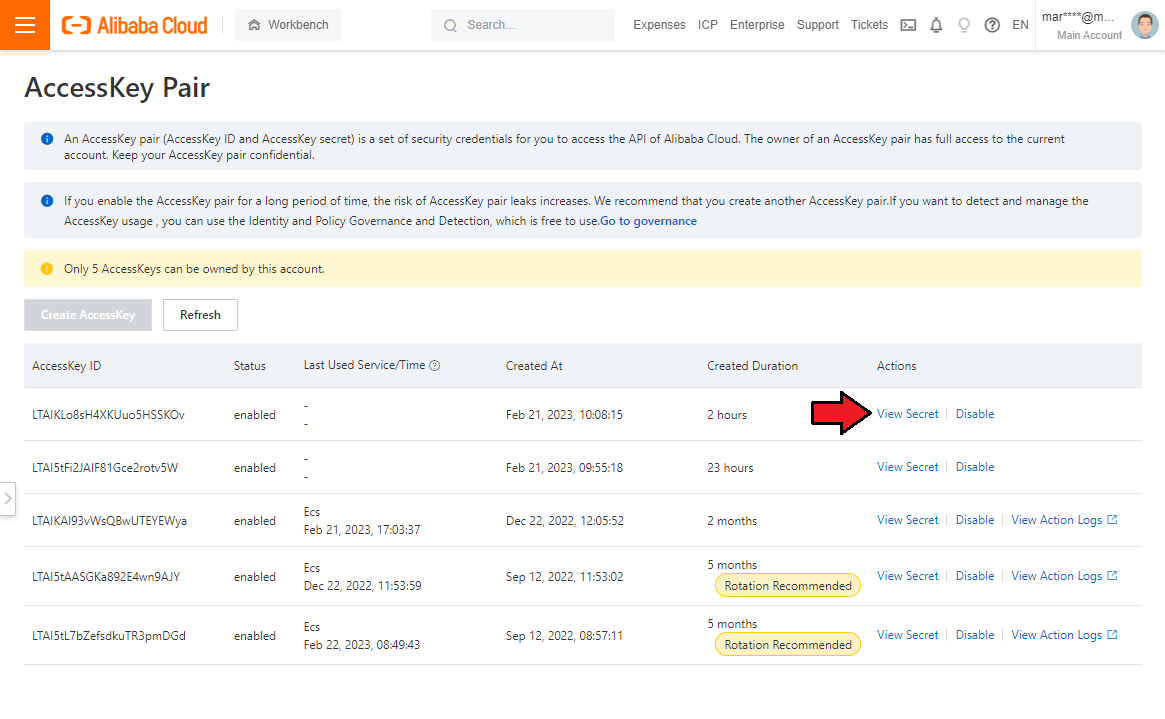
|
| 13. Now that you have you access keys, you may move back to your WHMCS. Proceed to 'System Settings' → 'Servers' and press 'Add New Server'. |
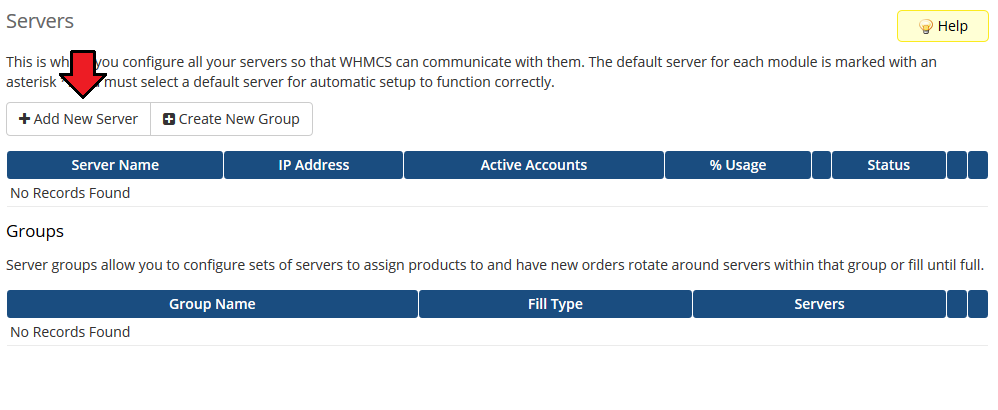
|
| 14. Next, enter your server name, fill in the 'Hostname' field, you may provide any data here, the provided content is not used in any way by the module. Move to the "server Details", select 'Alibaba Cloud Virtual Machines' from the 'Module' field. |
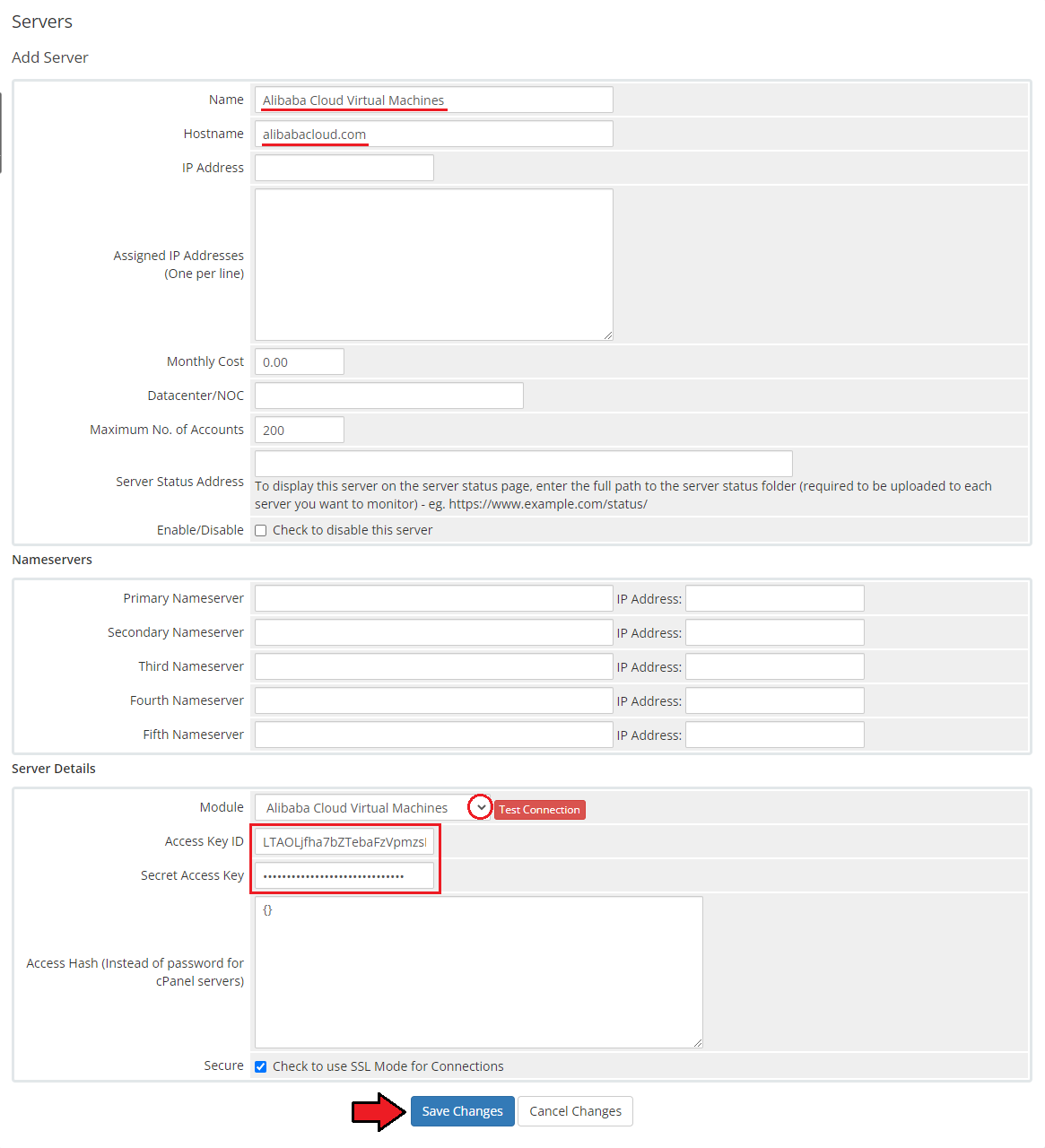
|
| 15. It is time to create a server group. To do so, click on 'Create New Group' . |
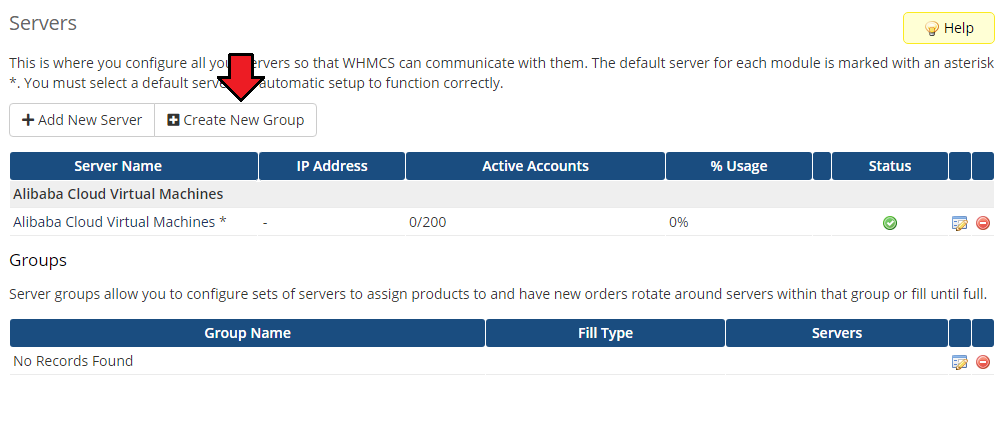
|
| 16. Enter a name, click on your previously created server, press 'Add' and afterward 'Save Changes' . |
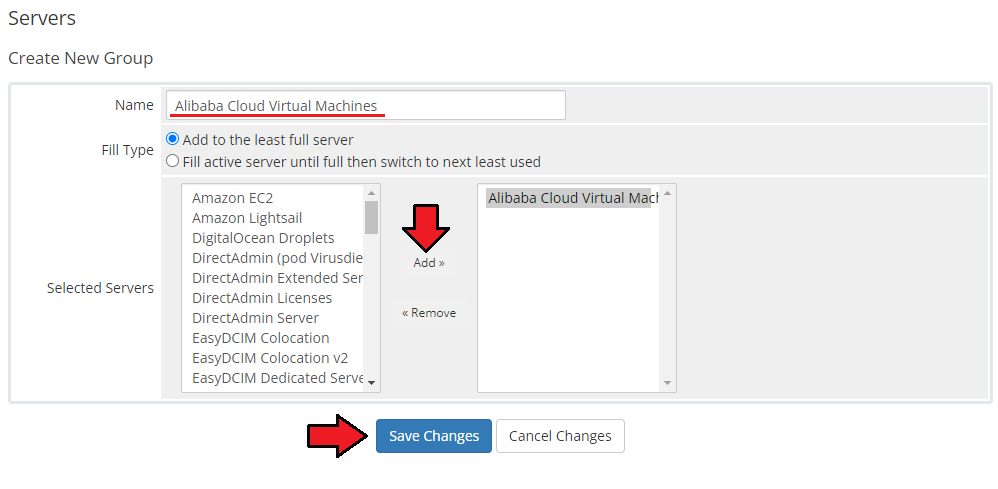
|
Configuration of Product
| 15. In order to create and configure a product, go to 'Setup' → 'Products/Services' → 'Products/Services'. Click on 'Create a New Group'. |

|
| 16. Enter your product group name and press 'Save Changes'. |

|
| 17. Once you have a product group, you can create a new product. To do so, first click on 'Create a New Product'. |

|
| 18. Afterward, choose your product type, enter your product name, choose module and the product group from the dropdown menus. Press 'Continue'. |

|
| 19. Now, go to the 'Module Settings' section, choose your previously created server group from the dropdown menu. The module should automatically save and reload the settings. If not, click on the 'Save Changes' option manually. |
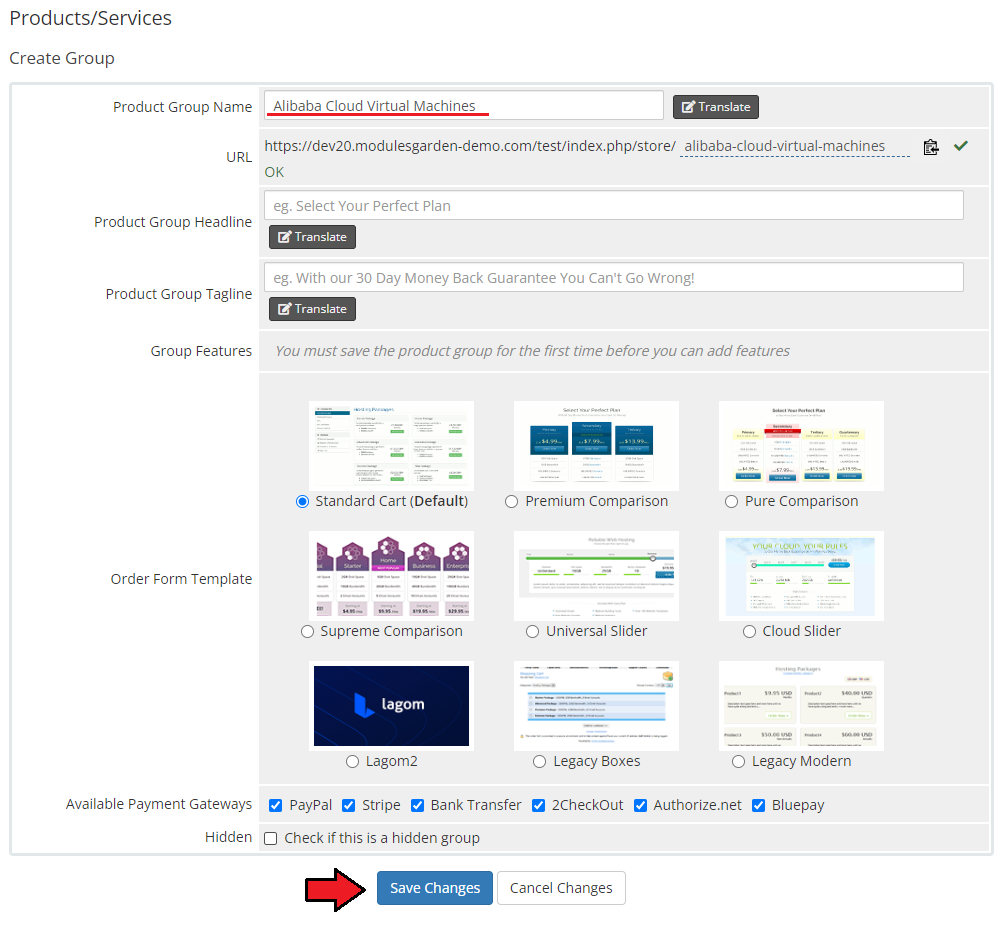
|
| 20. Now, you can start configuring the settings of the server you sell. |

|
| 21. The following section is dedicated to ..... |
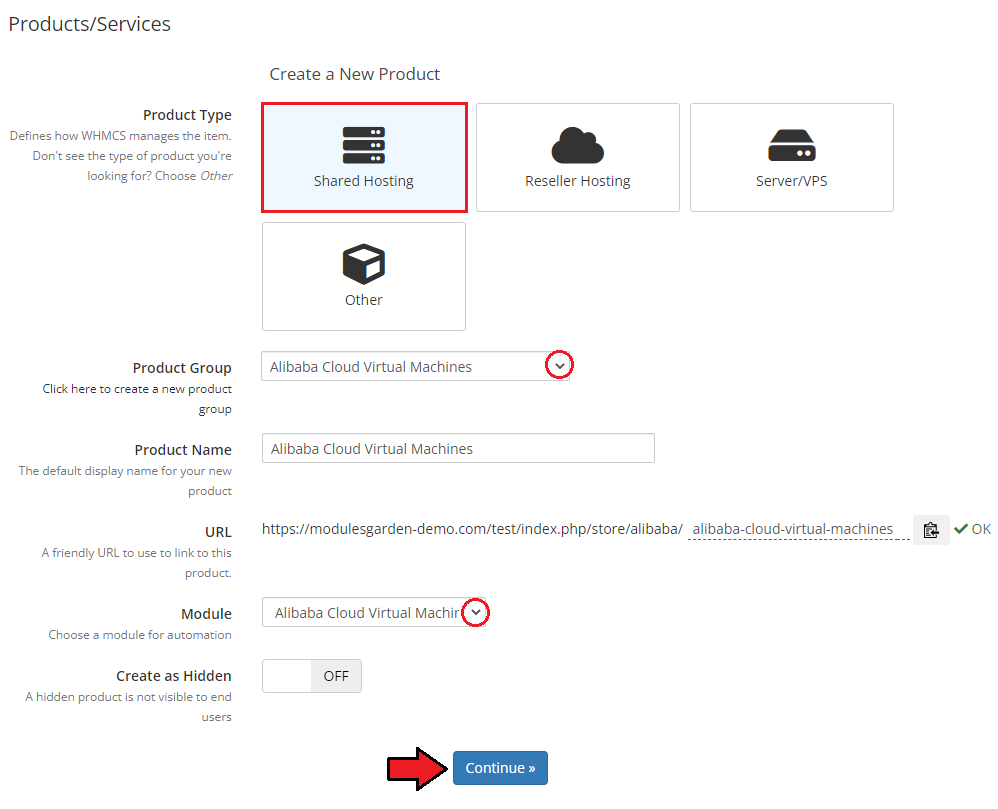
|
| 22. At the end of the configuration process, you can decide whether you want to generate configurable options for the product. Configurable options can be used by your clients to select each virtual machine parameters individually during order placement. |
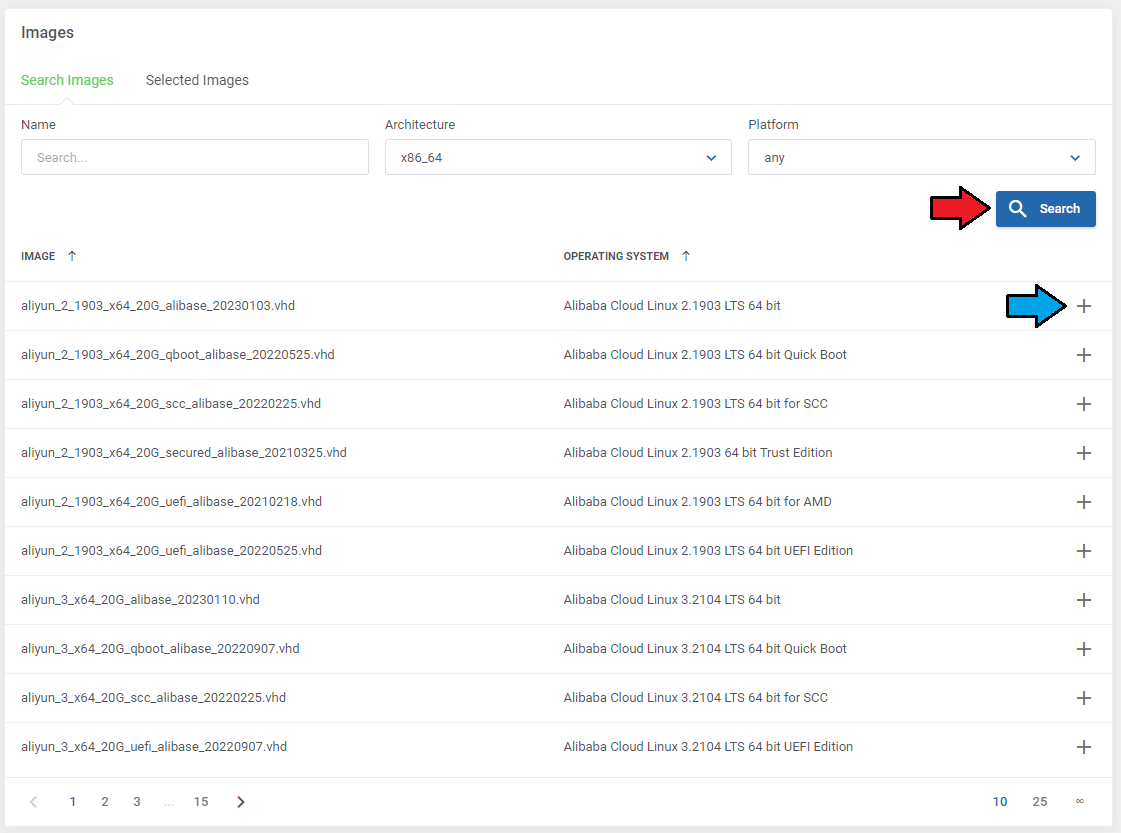
|
| If you decide to use configurable options, press on the 'Create' button and select which options you want to generate. Note that the configuration for disabled options will still be taken from the configuration of the main product. More information about how to use configurable options can be found here or in the official WHMCS documentation. |
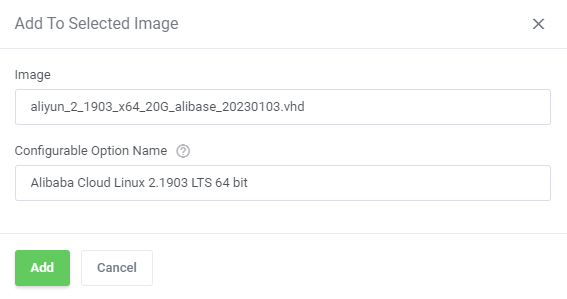
|
Management
Admin Area
| Amazon EC2 For WHMCS allows you to monitor and manage your customer server instance from the admin area of your WHMCS system. This includes supervision of such features as:
|
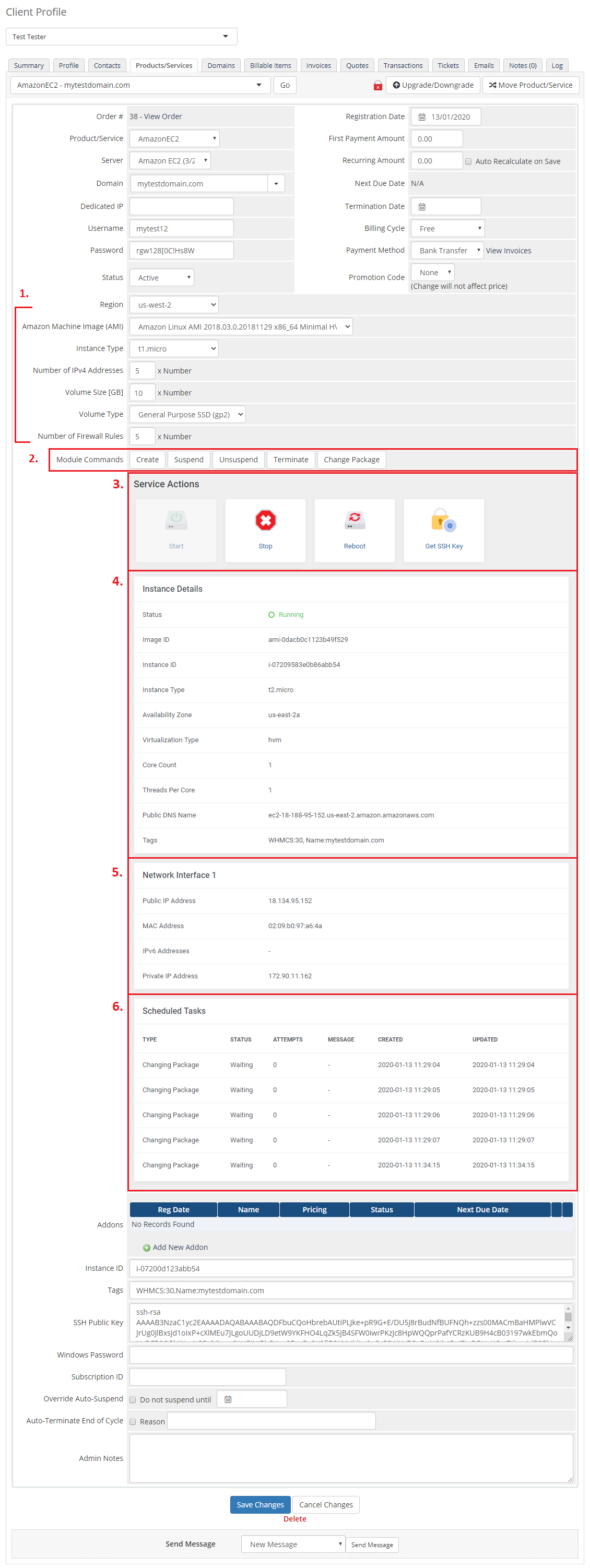
|
Ordering
| Thanks to configurable options, you are able to offer a product which your clients can tailor according to their needs. Additionally, you are able to set up pricing for each configurable option, which makes your offer even more competitive. At this moment you also have to provide the SSH key. Note that this key should be in one of the OpenSSH standard formats which are supported by API, e.g. ssh-rsa. |
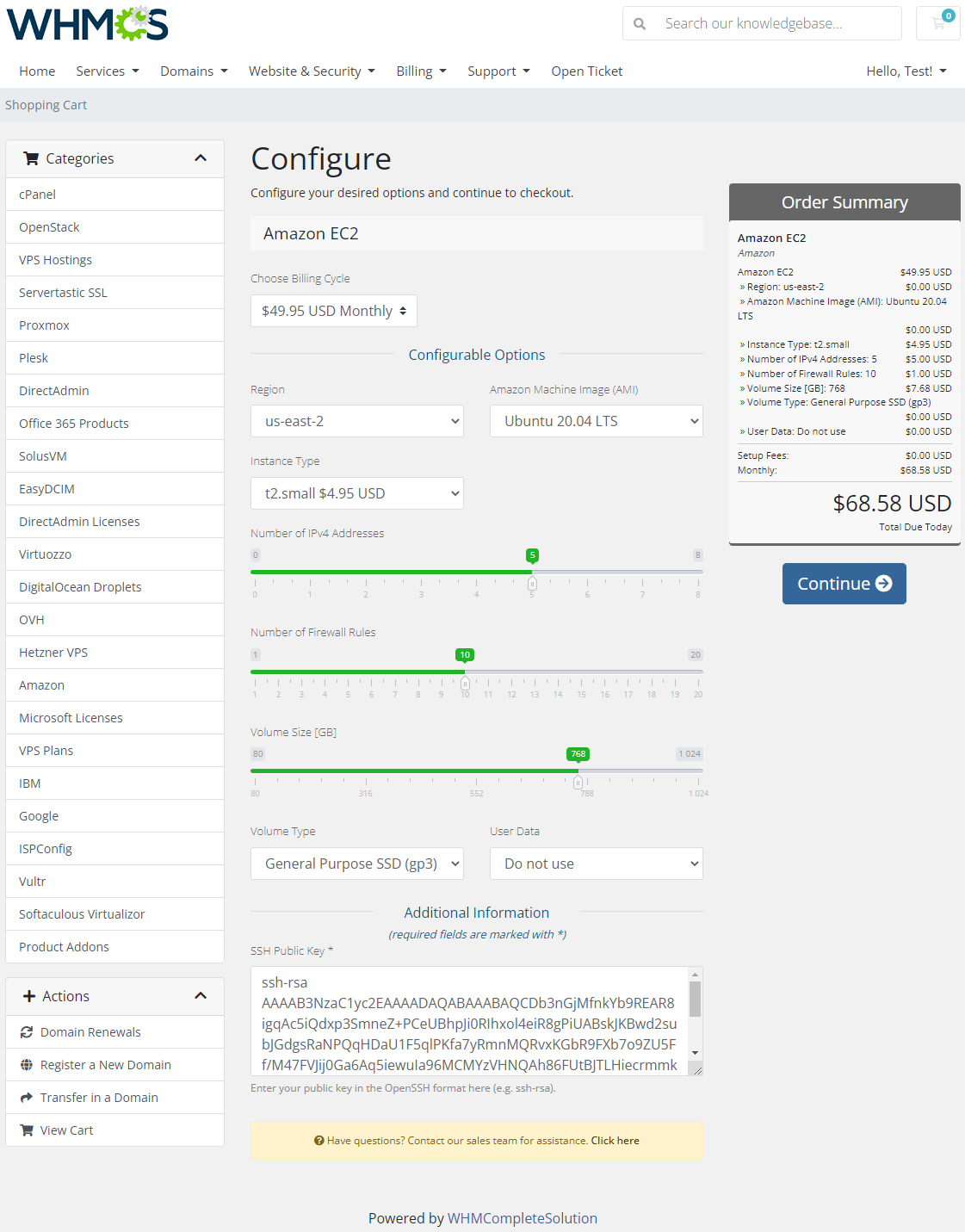
|
Importing Existing Instance
| In this section, you can find short instruction on how to connect one of your clients to your already existing instance in the Amazon EC2 panel. Take the following steps to make sure that the process will be carried out properly. 1. Firstly, manually create an order for your customer in WHMCS. Choose a client and in the summary, view click on the ' Add New Order' button. Next, select a 'Product/Service' and press 'Submit Order' .
The above-mentioned information has to be consistent with the data from your Amazon EC2 panel. Now, complete these fields as presented below. |
| 3. If the completed data is correct, after refreshing the page, you will see the attached instance from Amazon EC2. Important! Remember to manually add other missing parameters of the instance such as domains, credentials, IP Addresses, configurable options, SSH Key, billing cycle, etc. so they match the parameters of the attached instance from Amazon EC2. |
Client Area
| The client area interface of Amazon EC2 should look like the one on the screen below. As you can see, the control panel contains useful details of the managed server. The module allows your customers to easily start, stop and reboot their server instance through pressing the corresponding buttons. |
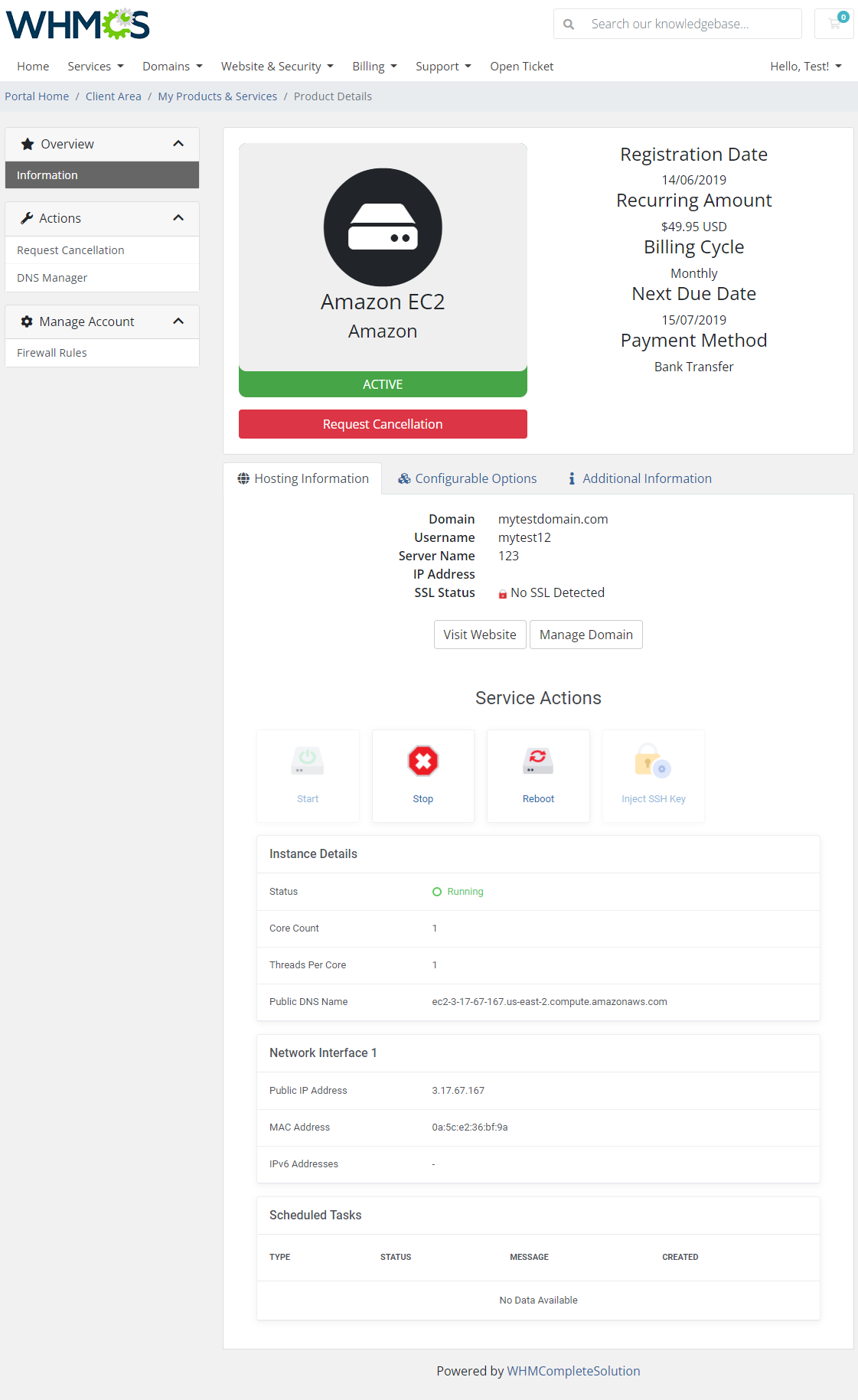
|
Firewall Rules
| Under the 'Firewall Rules' section, you may quickly add as well as remove 'Firewall Rules' . Note: Please remember that if the 'Add' button is unavailable, you have probably reached the rule limit set by the administrator. |
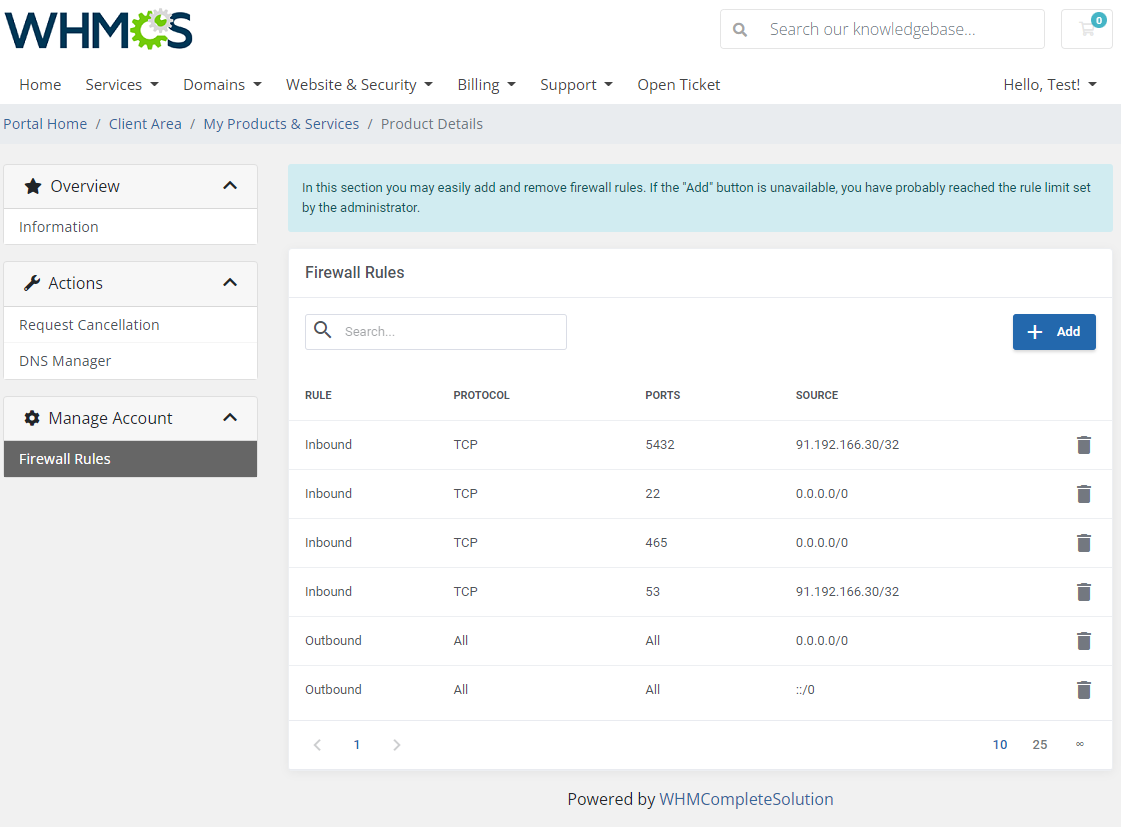
|
| Complete the details of your new security group rule and confirm by clicking 'Add' . |
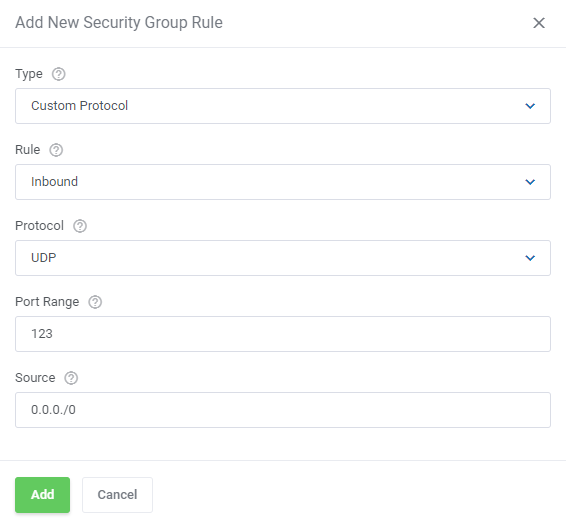
|
Tips
| 1. You must firstly stop the machine to let the change package action be successfully completed. |
| 2. In case you need to generate any of the configurable options once again, you must delete the previously created one. Only then it will be possible to generate a new configurable option. Read more about configurable options here. |
| 3. Amazon EC2 module supports all the default WHMCS marge field variables, they can be freely used in the welcome email template. Read more about module parameters here. The module also supports the below listed AWS variables: 'AmiLaunchIndex', 'ImageId', 'InstanceId', 'InstanceType', 'KeyName', 'Monitoring_State', 'Placement_AvailabilityZone', 'Placement_GroupName', 'Placement_Tenancy', 'PrivateDnsName', 'PrivateIpAddress', 'ProductCodes', 'PublicDnsName', 'State_Code', 'State_Name', 'StateTransitionReason', 'SubnetId', 'VpcId', 'Architecture', 'BlockDeviceMappings', 'ClientToken', 'EbsOptimized', 'EnaSupport', 'Hypervisor', 'NetworkInterfaces_0_Attachment_AttachmentId', 'NetworkInterfaces_0_Attachment_DeleteOnTermination', 'NetworkInterfaces_0_Attachment_DeviceIndex', 'NetworkInterfaces_0_Attachment_Status', 'NetworkInterfaces_0_Description', 'NetworkInterfaces_0_Groups_0_GroupName', 'NetworkInterfaces_0_Groups_0_GroupId', 'NetworkInterfaces_0_Ipv6Addresses', 'NetworkInterfaces_0_MacAddress', 'NetworkInterfaces_0_NetworkInterfaceId', 'NetworkInterfaces_0_OwnerId', 'NetworkInterfaces_0_PrivateDnsName', 'NetworkInterfaces_0_PrivateIpAddress', 'NetworkInterfaces_0_PrivateIpAddresses_0_Primary', 'NetworkInterfaces_0_PrivateIpAddresses_0_PrivateDnsName', 'NetworkInterfaces_0_PrivateIpAddresses_0_PrivateIpAddress', 'NetworkInterfaces_0_SourceDestCheck', 'NetworkInterfaces_0_Status', 'NetworkInterfaces_0_SubnetId', 'NetworkInterfaces_0_VpcId', 'NetworkInterfaces_0_InterfaceType', 'RootDeviceName', 'RootDeviceType', 'SecurityGroups_0_GroupName', 'SecurityGroups_0_GroupId', 'SourceDestCheck', 'StateReason_Code', 'StateReason_Message', 'Tags_0_Key', 'Tags_0_Value', 'Tags_1_Key', 'Tags_1_Value', 'VirtualizationType', 'CpuOptions_CoreCount', 'CpuOptions_ThreadsPerCore', 'CapacityReservationSpecification_CapacityReservationPreference', 'HibernationOptions_Configured', 'MetadataOptions_State', 'MetadataOptions_HttpTokens', 'MetadataOptions_HttpPutResponseHopLimit', 'MetadataOptions_HttpEndpoint' |
Update Instructions
| An essential guidance through the process of updating the module is offered here. Keep in mind there is a quick and easy option in our client area that will let you upgrade the license of your module to an open source version at any time - and at a lower price! |
Common Problems
| 1. When you have problems with connection, check whether your SELinux or firewall does not block ports. |